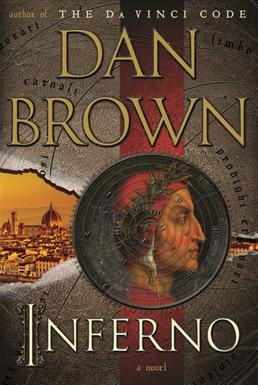 Never again will I complain about my nose.
Never again will I complain about my nose.
This is my first book review. Ever. To give you guys a little bit of background on my credentials, so to speak, I am proud to say I’ve been an avid book reader for the same amount of time I’ve been a video gamer: as long as I can remember. There are no bookstores within an hour of where I live. I don’t usually follow many authors or keep track of book releases anymore. When my time for hobbies significantly declined, my book nerdiness sadly became second to my gaming geekiness.
With that being said, there are some authors whose books I still devour whenever I see a new release. Not only have I read all of Dan Brown’s novels, I’ve also read Dante’s Inferno about four times thanks to taking advanced literature courses in high school and obtaining a Creative Writing Degree. Imagine my pleasant surprise when I walked into my local Wal*Mart and laid eyes upon a release poster featuring a new book by Dan Brown with a familiar face adorning the cover.
With The DaVinci Code shaking the world a few years ago and earning itself a film adaptation as well as Angels & Demons (thanks to Hollywood all I see is Tom Hanks when I read his books now) Dan Brown has become a New York Times bestseller and *almost* become a household name. I imagine most clergymen curse his name, but anyway, he’s pretty much guaranteed a ton of publicity whenever he releases a new book. And rightfully so. I mean, his last novel, The Lost Symbol, had five years worth of research to back up all of his points. I believe this is the key to his success. Dan Brown’s not some random lunatic spouting cataclysmic talking points from his ass. Everything in his novels is based on fact. Facts open the general public’s eyes, scaring religious and political leaders into facing controversies head-on and airing out their dirty laundry.
If you’ve read any of Dan Brown’s novels, you already know his style: race-against-time erudite thriller featuring a smart male lead with a smart-in-another-way cute female sidekick. At least I know what to expect, I guess, but it’d be nice if he’d push the boundaries of his self-induced limitations. You know, shake things up a bit. Inferno features the same static protagonist as three of his other novels: Robert Langdon. Langdon is a Harvard professor who uses his eidetic memory and love of snobby artsy-fartsy stuff to save the world.
This basic formula, while feeling worn at times, always manages to pull me in. There’s a variety of reasons for this. I enjoy thrillers, especially so if the author is smart about when to throw in those curveballs the reader (hopefully) isn’t suspecting. Brown is good at this. I also have a love of culture, and his books explore with vivid detail all aspects of culture; entwining art, literature, science, religion–you name it– with sophisticated brilliance. In this particular book’s case, Brown’s criminal mastermind du jour has a fixation on Dante Alighieri and the famous writer’s popular epic poem, The Divine Comedy.
If you think you don’t know anything about The Divine Comedy, you’re wrong. We all do, you just might not realize you do. The Divine Comedy’s most popular section is the first: The Inferno. Some Catholics canonized his unique structure of hell which features a hairy upside-down Satan at its core. There was even a video game loosely based on it, for God’s sake. Dante’s Inferno was the name of it actually, and it was a pretty fun God of War knockoff if you want to check it out. Point being: our culture is saturated with hundreds of references to this classic piece of literature, and Dan Brown paid it homage in a creative manner.
Another reason I like Dan Brown’s books is because he takes the reader through detailed travels across the world. Appropriately, Inferno spends a chunk of time in Florence, Italy (Dante Alighieri’s hometown). I have a nerdy love for ancient buildings and art. I’m also not independently wealthy and don’t foresee myself having the opportunity to travel to any of these places anytime soon. Dan Brown dedicates plenty of time to describing awesome sculptures, paintings, and famous landmarks. He takes the time to place the reader in the setting among the frantic nature of his tale. A great substitute for not being physically present. Too bad there aren’t picture guides in my edition. Yes, the book could be about 100 pages shorter if he didn’t spend as much time explaining the intricate details of certain masterpieces. However, as his work has nonfiction roots, he must show the reader he knows what he’s talking about and establish the foundation for the greater plot significance of it all. Dan Brown doesn’t usually throw in half-page descriptors for no reason.
He also somehow knows I like to feel smart. Seriously. If your memory is better than mine, (and that isn’t saying much), you’ll be amazed at the history and factual input he takes the time to address. Oftentimes I would read a page and stare off into space, trying to commit to memory the incredible stuff I’d just read. Yes, I’m a dork like that. If you’re a dork in this sense, you’ll probably enjoy this book for all the same reasons.
Dan Brown throws in overarching queries in his books. You know, those grey morality issues we don’t like to think about. Unlike many of his previous books, this bigger question isn’t particularly aimed at religious folks. In a way it is, but the unquestionable facts pertain to the human race as a whole. The “What if?” question at the end really had me pondering what my personal stance on the whole issue is.
I’m still undecided, by the way.
I’m not going to give a whole plot synopsis or spoilers, they’re pasted all over the internet. But I will say if you like conspiracy theories, thrillers, or just plain appreciate Dante’s Inferno, you should dedicate some time to this page-turner. Once I started this book the pages kept turning and before I knew it the end was nigh and I didn’t want the chase to be over.
